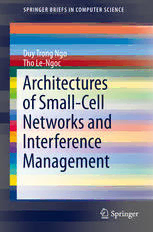Table Of ContentSPRINGER BRIEFS IN COMPUTER SCIENCE
Duy Trong Ngo
Tho Le-Ngoc
Architectures
of Small-Cell
Networks and
Interference
Management
123
SpringerBriefs in Computer Science
SeriesEditors
StanZdonik
PengNing
ShashiShekhar
JonathanKatz
XindongWu
LakhmiC.Jain
DavidPadua
Xuemin(Sherman)Shen
BorkoFurht
V.S.Subrahmanian
MartialHebert
KatsushiIkeuchi
BrunoSiciliano
Forfurthervolumes:
http://www.springer.com/series/10028
Duy Trong Ngo • Tho Le-Ngoc
Architectures of Small-Cell
Networks and Interference
Management
123
DuyTrongNgo ThoLe-Ngoc
SchoolofElectricalEngineering DepartmentofElectrical
andComputerScience andComputerEngineering
UniversityofNewcastle McGillUniversity
Callaghan,NSW,Australia Montreal,QC,Canada
ISSN2191-5768 ISSN2191-5776(electronic)
ISBN978-3-319-04821-5 ISBN978-3-319-04822-2(eBook)
DOI10.1007/978-3-319-04822-2
SpringerChamHeidelbergNewYorkDordrechtLondon
LibraryofCongressControlNumber:2014932974
©TheAuthor(s)2014
Thisworkissubjecttocopyright.AllrightsarereservedbythePublisher,whetherthewholeorpartof
thematerialisconcerned,specificallytherightsoftranslation,reprinting,reuseofillustrations,recitation,
broadcasting,reproductiononmicrofilmsorinanyotherphysicalway,andtransmissionorinformation
storageandretrieval,electronicadaptation,computersoftware,orbysimilarordissimilarmethodology
nowknownorhereafterdeveloped.Exemptedfromthislegalreservationarebriefexcerptsinconnection
with reviews or scholarly analysis or material supplied specifically for the purpose of being entered
and executed on a computer system, for exclusive use by the purchaser of the work. Duplication of
this publication or parts thereof is permitted only under the provisions of the Copyright Law of the
Publisher’slocation,initscurrentversion,andpermissionforusemustalwaysbeobtainedfromSpringer.
PermissionsforusemaybeobtainedthroughRightsLinkattheCopyrightClearanceCenter.Violations
areliabletoprosecutionundertherespectiveCopyrightLaw.
Theuseofgeneraldescriptivenames,registerednames,trademarks,servicemarks,etc.inthispublication
doesnotimply,evenintheabsenceofaspecificstatement,thatsuchnamesareexemptfromtherelevant
protectivelawsandregulationsandthereforefreeforgeneraluse.
While the advice and information in this book are believed to be true and accurate at the date of
publication,neithertheauthorsnortheeditorsnorthepublishercanacceptanylegalresponsibilityfor
anyerrorsoromissionsthatmaybemade.Thepublishermakesnowarranty,expressorimplied,with
respecttothematerialcontainedherein.
Printedonacid-freepaper
SpringerispartofSpringerScience+BusinessMedia(www.springer.com)
Preface
Toaccommodatetheever-increasingdemandformobiledata,thewirelessindustry
isfacingwiththeurgentrequirementofgrowingthecapacityofmobileaccessnet-
worksby1;000times.Theextremedensificationofsmallcellsiscurrentlythebig
hopetoresolvetheunprecedent“1000(cid:2)datachallenge”andtoprovideubiquitous
network coverage with an optimized grade of service. Small-cell heterogeneous
networks represent a paradigm shift from the traditional centralized macrocell
approach to a more self-organized solution, where small cells are deployed in
conjunction with existing large cells at all possible venues, indoors and outdoors,
and in all types and sizes. However, the coexistence of different types of network
deviceswithdiversespecificationsonthesamespectrumraisesanewsetofmajor
design issues. These critical challenges urgently need to be solved to fully realize
thepromisedbenefitsofsmall-cellsolutions.
This SpringerBrief covers two important aspects of the emerging small-cell
wireless heterogeneous networks. First, the architectures of small-cell networks
are reviewed, with specific references to the current wireless network standards.
Second, new adaptive power control and dynamic spectrum access techniques are
discussedtopromoteaharmonizedcoexistenceofdiversenetworkentitiesinboth
3Gand4Gsmall-cellnetworks.Analyticallydevisedfromoptimizationandgame
theories, these autonomous solutions are shown to effectively manage the severe
intra-tier and cross-tier interferences in small cells. The target audience of this
informativeandpracticalSpringerBriefisresearchersandprofessionalsworkingin
wirelessnetworkingandinterferencemanagement.Thecontentisalsovaluablefor
advanced-level students interested in network communications and radio resource
allocation.
WewouldliketoacknowledgethefinancialsupportsfromtheNaturalSciences
and Engineering Research Council of Canada and the Alexander Graham Bell
CanadaGraduateScholarship.
Finally,wededicatethisworktoourfamilies.
Callaghan,NSW,Australia DuyTrongNgo
Montreal,QC,Canada ThoLe-Ngoc
v
Contents
1 DenseSmall-CellNetworks:MotivationsandIssues .................... 1
1.1 MobileDataTrafficandIndoorCoverageChallenges................ 1
1.2 ExtremeNetworkDensificationSolution.............................. 2
1.2.1 FrequencyReusePrincipleandCellularWireless
Networks........................................................ 3
1.2.2 Small-CellHeterogeneousNetworkDeployment............. 5
1.2.3 TechnicalChallengesinSmallCells........................... 7
1.3 StructureoftheBrief.................................................... 8
References..................................................................... 10
2 ArchitecturesandInterferenceManagement
forSmall-CellNetworks..................................................... 11
2.1 Requirements and Reference Model for Small-Cell
NetworkArchitectures.................................................. 11
2.2 Small-CellArchitecturesinWirelessNetworkStandards ............ 13
2.2.1 3GPPUMTSSmall-CellArchitecture......................... 13
2.2.2 3GPPLTESmall-CellArchitecture............................ 14
2.2.3 3GPP2CDMA20001xSmall-CellArchitecture.............. 16
2.2.4 AirInterfaces:CDMAvs.OFDMA ........................... 16
2.3 InterferenceManagementinSmall-CellNetworks.................... 18
2.3.1 InterferenceScenarios.......................................... 18
2.3.2 PowerControlforCDMA-BasedWirelessNetworks ........ 19
2.3.3 JointSubchannel-PowerAllocationinOFDMANetworks... 23
References..................................................................... 28
3 DistributedInterferenceManagementinHeterogeneous
CDMASmall-CellNetworks................................................ 33
3.1 SystemModelandAssumptions ....................................... 34
3.2 DistributedJointPowerandAdmissionControlAlgorithms......... 37
3.2.1 QoSGuaranteeforMUEs...................................... 37
3.2.2 Dynamic Pricing, Power Adaptation and
AdmissionControlforFUEs................................... 39
vii
viii Contents
3.3 PracticalImplementationIssuesandFurtherExtensions ............. 44
3.3.1 CommunicationOverheadofProposedAlgorithms .......... 44
3.3.2 ImprovingEfficiencyofEquilibriumSolutions............... 44
3.4 IllustrativeResults ...................................................... 45
References..................................................................... 49
4 Distributed Pareto-Optimal Power Control for Utility
MaximizationinHeterogeneousCDMASmall-CellNetworks ......... 51
4.1 SystemModelandProblemFormulation.............................. 52
4.2 DistributedPowerControlforJointUtilityMaximization
withMacrocellQoSProtection......................................... 56
4.2.1 Pareto-OptimalSINRBoundaryandApproximate
SolutionviaLog-BarrierPenaltyMethod..................... 56
4.2.2 DistributedAlgorithmforGloballyMaximized
JointUtility ..................................................... 59
4.3 Distributed Power Control for Femtocell Utility
MaximizationandMacrocellSINRBalancing........................ 60
4.3.1 DistributedPareto-OptimalSINRAssignment................ 61
4.3.2 Distributed Algorithm for Femtocell Utility
MaximizationandMacrocellSINRBalancing................ 64
4.3.3 AdvantagesofFUM-MSBAlgorithm......................... 65
4.4 IllustrativeResults ...................................................... 66
References..................................................................... 70
5 JointPowerandSubchannelAllocationinHeterogeneous
OFDMASmall-CellNetworks.............................................. 73
5.1 SystemModelandProblemFormulation.............................. 74
5.2 AnIterativeApproachtoJointPowerandSubchannelAllocation... 77
5.2.1 FeasibilityandInitialFeasibleAllocation..................... 78
5.2.2 OptimalSubchannelAssignmentforFixedPower
Allocation....................................................... 79
5.2.3 OptimalPowerAllocationforFixedSubchannel
Assignment...................................................... 80
5.3 Proposed Joint Power and Subchannel Allocation
AlgorithmswithMacrocellTotalThroughputProtection............. 85
5.3.1 CentralizedSCA-basedPowerAllocationwith
AGMApproximation........................................... 86
5.3.2 Distributed SCA-based Power Allocation
withLogarithmicApproximation.............................. 87
5.3.3 DistributedSCA-basedPowerAllocationwith
D.C.Approximation............................................ 90
5.4 IllustrativeResults ...................................................... 92
References..................................................................... 96
Contents ix
6 DistributedResource AllocationinOFDMACognitive
Small-CellNetworkswithSpectrum-SharingConstraints.............. 99
6.1 SystemModelandProblemFormulation.............................. 100
6.2 JointSubchannelandPowerAllocationforThroughput
MaximizationinCognitiveFemtocellNetworks...................... 104
6.2.1 OptimalDesignwithSpectrum-SharingConstraints ......... 104
6.2.2 DistributedImplementation.................................... 107
6.3 ADualApproachtoPower-EfficientResourceAllocation........... 110
6.4 Reduced-ComplexitySchemesforThroughputMaximization....... 112
6.5 PerformanceEvaluation ................................................ 113
6.5.1 AsymptoticComplexityAnalysis.............................. 113
6.5.2 IllustrativeResults.............................................. 115
References..................................................................... 120

